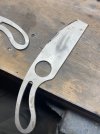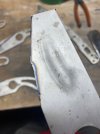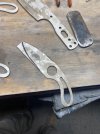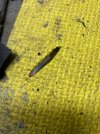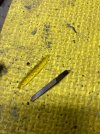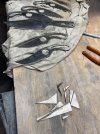I often see people hesitating to make modifications to a knife they own because they wonder if they’ll ruin heat treatment. Someone worried recently about cutting off the wave on an Emerson.
Let me show you and angle grinder cut I performed on some hardened blanks before cleaning up the profile on my belt grinder:
View attachment 2664173
View attachment 2664174
View attachment 2664185
That is the same blank from two different sides. As you can see there is a rainbow that goes from white to blue to brown to straw. The white and blue parts are demolished, and would never hold a proper edge (if we assumed that part of the profile wasn’t going to be removed during profile clean up, which it was).
The brown and straw, as I understand it, have little to no affect. So when grinding (or sharpening) any blade, I go the overprotective route and take steps not to build up enough heat to change color at all.
Now that pic was with a careful bit quick angle grinder cut. You can see that the heat that would affect the microstructure transferred only a mm or two into the profile.
So cutting a wave off an Emerson isn’t going to do anything to affect the heat treatment of the edge, and if anything you’ll end up with a small spot on the spine that’s a little softer.
 David Mary
this earlier today and he gave me his input and now I pose this question to the forum. I’d love to hear from any and all.
David Mary
this earlier today and he gave me his input and now I pose this question to the forum. I’d love to hear from any and all. 

